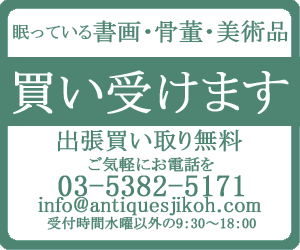マリー・ローランサンのリトグラフ「バランタン」を、ヤフーショッピングで販売しております。
マリー・ローランサン「バランタン」 サイン 6/350 リトグラフ
慈光では、絵画の販売、お買い取りを行っております。
今回ご紹介する品物は、マリーローランサンのリトグラフ『バランタン』です。マリーローランサンはフランスのパリ生まれの画家で女流作家を代表する画家です。当時のフランスパリの黄金期の時代を過ごし、かの有名なバトー・ラヴォワール(洗濯船)のアトリエで、ピカソや詩人などと出会い交流があり文化人としても名が知られています。
独特なタッチや妖艶な世界感があり、日本でも非常に人気のある作家です。
お問い合わせ先
info@antiquesjikoh.com
(有)アンティーク・ネット慈光
TEL/FAX 03-3395-7481
買取のご相談は TEL/ 03-5382-5171
営業時間 10:00~18:00(水曜日休)



















